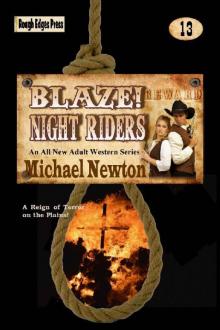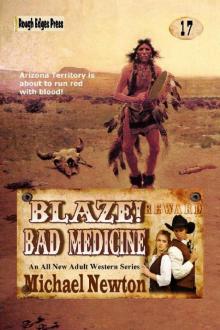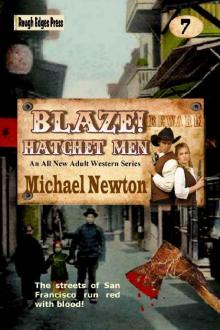- Home
- Michael Newton
The Texarkana Moonlight Murders: The Unsolved Case of the 1946 Phantom Killer Page 2
The Texarkana Moonlight Murders: The Unsolved Case of the 1946 Phantom Killer Read online
Page 2
Resistance, in the form of a bewildered silence, thus “justified” a campaign of murder, rape, and enslavement. Caddos who survived the first onslaught fell prey to the diseases carried by their “saviors,” and were further decimated. Later, conflict with invaders from the Osage Nation finished off the work begun by Spain.4
Next on the scene was French explorer Jean-Baptiste Bénard de la Harpe, reaching the Red River near present-day Texarkana in April 1719. Hoping to frustrate Spanish territorial expansion, he built a small fort and trading post—Le Poste des Cadodaquious—northwest of the city’s present site, then moved on to trade with the Wichita people. La Harpe’s outpost was occupied until 1770, but had fallen into disrepair by 1806, when President Thomas Jefferson dispatched the Red River Expedition to explore that portion of his Louisiana Purchase.5
That vast tract of land, purchased from France at a cost of three cents per acre, ultimately yielded fifteen states—including Arkansas, established as a territory on July 4, 1819. Miller County, created on April 1, 1820, and named for the territory’s first governor, originally encompassed its own present territory, plus eleven future Texas counties: Bowie, Red River, Lamar, Fannin, Cass, Morris, Titus, Franklin, Hopkins, Delta, and Hunt.6
Texas, next door, was a whole other story.
Spanish explorer Alonso Álvarez de Pineda drew the first map depicting Texas in 1519. Nine years later, Álvar Núñez Cabeza de Vaca was shipwrecked on the Gulf Coast with his crew, reporting that “half the natives died from a disease of the bowels and blamed us.” Once Cabeza de Vaca escaped, Europe ignored Texas until 1685, when Frenchman René-Robert Cavelier de La Salle mistakenly landed at Matagorda Bay, rather than the Mississippi River’s mouth. He founded Fort Saint Louis, which inspired a spate of mission-building by Spaniards who feared French encroachment. Aboriginal tribes fought both invaders, but were decimated in return.7
In February 1819, five months before Arkansas Territory was created, the Adams–Onís Treaty established the Sabine River as a boundary between New Spain and the United States. Neither side was happy with the choice: “filibuster” parties—private Anglo armies—staged sporadic raids across the river, while the Mexican War of Independence incorporated Texas as a new Mexican state, Coahuila y Tejas, under the Constitution of 1824. By then, Stephen Austin and his “Old Three Hundred” settlers had put down roots in Texas, planting cotton that was picked by slaves. “Oppressed” by Mexican demands for liberation of their human chattel and compliance with the terms of their initial settlement—i.e., conversion to the Roman Catholic religion—Austin’s “Texians” rebelled in 1835 and established a Republic of Texas early the following year, annexed to the United States in December 1845.8
Meanwhile, Arkansas suffered a falling out with its oversized neighbor. Miller County, during 1836, sent representatives to both the Arkansas territorial legislature and to the Texas Congress. Texas spoiled that harmony by creating Red River County in 1837 and Fannin County in 1838. Arkansas retaliated by making it a misdemeanor for citizens to hold office both in Miller County and in Texas, but legislators failed in their efforts to establish a county court during 1838, so they abolished Miller County instead. Texas created Bowie County—named for knife-fighter and Alamo martyr James Bowie—in December 1840, initially including parts of present-day Cass, Titus, and Morris counties, reduced to its present size in 1846. Miller County was not recreated until 1874, with Texarakana as its county seat.9
Life was hard—and often cheap—on both sides of the new state border drawn in 1845.
To begin with, Anglo-European settlers faced incessant conflict with Southern Plains Indians and Apaches. Whites suffered losses, but were everywhere victorious, eliminating an estimated 95 percent of the aboriginal population from Texas between 1528 and 1890.10 Arkansas was slightly less brutal—and recruited a Confederate Indian Army under General Albert Pike to kill Yankees during the Civil War—but the end result for Native Americans was equally dismal.11
Reconstruction brought endemic violence to both Arkansas and Texas, from 1865 to 1877. White terrorist groups such as the Ku Klux Klan, Knights of the White Camellia, and Knights of the Rising Sun operated as de facto guerrilla arms of the white-supremacist Democratic Party, murdering hundreds of newly-freed blacks and “radical” Republicans, flogging and mutilating hundreds more. Texas shivered on the brink of anarchy, prompting General Philip Sheridan, commander of the district during 1867, to remark, “If I owned Hell and Texas, I would rent out Texas and live in Hell.”12
Joining in the general mayhem was Cullen Montgomery Baker, a Tennessee native raised in Clarksville, Arkansas, later renowned in the saloons of Miller and Lafayette Counties for his alcoholism and violent temper. Baker joined the Confederate Army in 1862, then deserted in 1864 to lead his own band of lawless “Independent Rangers,” raiding homesteads whose able-bodied men were off in uniform. In November 1864 his gang killed ten unarmed settlers on the Saline River, and Cullen personally shot four African American soldiers at Spanish Bluffs a month later, killing one. Continuing his reign of terror into Reconstruction, Baker killed a Union sergeant at New Boston, Bowie County, in March 1866. More murders followed—hundreds by some accounts, though more conservative historians list fifty or sixty. Operating from a base near present-day Texarkana, Baker finally met his end in January 1869, in a shootout at Bloomburg, Texas, where city fathers still host a yearly Cullen Baker Country Fair to benefit their volunteer fire department.13
Baker was nearly five years in the ground before Texarkana’s birth. Builders of the Texas and Pacific Railroad began selling lots at the future town site on December 8, 1873, with the first bought by J. W. Davis where the Hotel McCartney now stands, opposite Union Station. A bridge spanning the Red River opened on March 20, 1874, permitting a link-up with the Iron Mountain Railroad’s track to Little Rock, ensuring continuous traffic through town. An Iron Mountain surveyor, Colonel Gus Knobel, nailed a placard to an ancient tree, reading: “TEX-ARK-ANA—This is the name of a town which is to be built here.” Knobel named the site for Texas, Arkansas, and Louisiana, mistakenly believing that the Pelican State’s northern border was two or three miles south of town. In fact, it was thirty miles, but the name stuck, regardless.14
Official recognition lagged a bit behind construction. Texas legislators granted their half of the city a charter in 1876, a year after the daily Texarkana Gazette began publication, but Razorback lawmakers stalled incorporation on the Arkansas side until 1880. The first post office opened on the Texas side in 1886, operating until 1892, when Congressman John Morris Sheppard obtained a federal order changing the address to “Texarkana, Arkansas-Texas.” Over time, lumber and manufacturing rivaled railroads as sources of local income.15
Civilization had arrived, but the area maintained its frontier flavor, and the city kept its rough-and-ready frontier edge, exacerbated by persistent, fruitless bids to legislate morality. Chief among the irritants were “drys”—self-righteous crusanders against alcohol for whom temperance meant total abstinence. Texas had banned saloons in 1845, but no one bothered to enforce the statute, and it was repealed in 1856. Twenty years later, a new constitution required the legislature to enact a local-option law, and fifty-three of 239 Texas counties banned alcohol by 1895. Arkansas was more lenient, though a state law passed in 1879 required biannual local referendums on sale of liquor in quantities under five gallons. Both states ratified the Eighteenth Amendment, banning liquor nationwide, in 1919, and America officially went “dry” in January 1920.16
The result was an unprecedented crime wave. While underpaid and easily corruptible police chased liquor violators, aided by a small force of federal agents and volunteers from the revived Ku Klux Klan, legions of smugglers and bootleggers kept the U.S. sopping wet and gleefully inebriated. Law enforcement officers who could not be paid off were easily eliminated, as the “Roaring Twenties” blazed with gunfire, birthing the country’s first national crime syndicate.
On May 19, 1922, Chief
of Police A. J. Lummus and Officer Dick Choate arrested suspect Hulen Owens on a larceny charge in Texarkana, Arkansas. Owens, an African American, confessed the theft and offered to produce the stolen merchandise. Lummus and Choate set off with Owens in the suspect’s car, toward an address on Pecan Street, where Owens bailed out of the vehicle and fled on foot. The officers trailed him to Andrew Howze’s home, arriving just as Owens climbed behind the wheel of a Chandler Coupe parked at the curb. Choate reached the car first, and fell lifeless in a blaze of pistol fire before Owens escaped. Traced to Index, eight miles north of Texarkana, Owens was returned to jail, where a white mob broke in and lynched him on May 19. Eight men were arraigned on murder charges, but no convictions resulted.17
On November 1, 1925, Miller County Sheriff Elisha “Lish” Barber and Deputy Bob Smith were summoned to a local shop, where ex-police chief Henry Adams and three friends were behaving in a disorderly manner. An argument ensued and guns were drawn. When the smoke cleared, Barber and Smith were dead, with Adams wounded and facing double murder charges.18
In the early morning hours of July 16, 1926, Texarkana Patrolman Hence Giles tried to arrest a suspected bootlegger on the Arkansas side, presumably unaware that his man was a convicted murderer on the run from a Texas lockup. The man killed Giles and fled, was captured in January 1928, then escaped from the Miller County jail and murdered Constable Roy Selman of the Little River County Sheriff’s Office. He was eventually nabbed in Sevier County, charged with three homicides.19
Three years later, on the Texas side, Officer James Walraven, Sr. arrested a local man for public intoxication. The embarrassed drunk brooded over that insult for two days, then confronted Walraven with a pistol, at a local filling station, on July 23, 1929. The gunman’s pistol misfired several times before inflicting a mortal wound on Walraven, who returned fire and killed his attacker on the spot.20
Three more Miller County sheriff’s deputies were slain in 1932, a year before the Twenty-first Amendment ended Prohibition’s “noble experiment.” On August 31, Deputy Berry Quillin was gunned down outside a pharmacy in Fouke, thirteen miles southeast of Texarkana, by moonshiners angry at his brother, who was a federal liquor agent.21 Deputies Melvin Brackman and J. C. Crain were shot from ambush during a liquor raid, on October 19. Brackman died instantly, while Crain survived until October 21.22
So it was that by 1946, a Texarkana policeman could say that his town was “calloused to murder.”23 Calloused, also, to the losses suffered during World War II, when 196 local men were lost on foreign seas and battlefields.24 No record states how many more returned, wounded in body and in mind by all they suffered during brutal combat with the Axis Powers overseas.
They came home to the same town they had left, politically divided along State Line Avenue. The veterans of Bowie County had to cross that street to buy a legal alcoholic drink, since theirs was one of forty-six Lone Star counties that stayed “dry” after Repeal, in 1933. Miller County was more liberal, permitting liquor sales on any day but Sunday.25 Jobs were plentiful for warriors coming home, in lumber mills and the munitions plants erected during wartime. The city thrived with 44,000 residents, and it was justly proud of certain native sons.
The list included Scott Joplin, America’s “King of Ragtime,” born in 1867 to a family of poor black laborers in Northeast Texas, raised in Texarkana. Joplin worked the local railroads through his early twenties, then left to travel the South as an itinerant musician, making his mark far from home. Despite that, and his death from tertiary syphilis in a New York City mental institution, on April 1, 1917, Texarkansans were proud to call Joplin one of their own.26
Huddie William Ledbetter—“Lead Belly,” to his fans—was another troubled prodigy. Born to sharecroppers on a Louisiana plantation, in January 1888, he was five years old when his parents moved to Bowie County, Texas. Noted for his singing voice and skill with a guitar by age fifteen, Ledbetter followed in Joplin’s footsteps, embarking on a transient career that led him through brothels and music halls into prison. Consigned to a Harrison County chain gang in 1915, for packing a concealed pistol, he escaped and returned to Bowie County, then knifed one of his relatives to death in a fight over a woman, in January 1918. Governor Pat Neff pardoned Ledbetter in 1925, in response to a musical plea for freedom, but Lead Belly stabbed a white man in 1930 and spent four years in Louisiana’s state prison for attempted murder. Released again in 1934, he achieved sufficient fame to rate a Life magazine article in April 1937, titled “Lead Belly—Bad Nigger Makes Good Minstrel.” Another stabbing, this one in New York City, added to his rap sheet in 1939.27
Conlon Nancarrow, another local youth, was born in Texarkana, Arkansas, in 1912. He played the trumpet in a local jazz band before leaving to refine his skills in Cincinnati, then in Boston—where he scandalized hometown conservatives by joining the Communist Party. After fighting in Spain’s civil war with the much-maligned Abraham Lincoln Brigade, Nancarrow spent time in a French internment camp, then moved to Mexico in 1940 and became a Mexican citizen in 1955. Renowned as a composer, much of whose work was written for player pianos, he enjoyed an American revival in the early early 1980s but refused to beg forgiveness by pleading youth and ignorance for his radical days. Some Texarkansans would forgive him, the transition eased by his demise in 1997.28
Other residents of Texarkana, though earmarked for greatness, could hardly foretell it in 1946. Future billionaire and independent presidential candidate Henry Ross Perot, son of a cotton broker, was four months shy of his sixteenth birthday on the night of the Hollis-Larey attack. He would watch the nightmare unfold as a student at Texas High School, following its subsequent developments during two years at Texarkana Junior College, before entering the U.S. Naval Academy and helping to establish that school’s honor system.29
Hayes McClerkin, a future state legislator and Speaker of the Arkansas House of Representatives, born on the Miller County side of State Line Avenue, was also just fifteen in February 1946. A boyhood friend of Ross Perot and later unsuccessful candidate for the lieutenant governor’s office, McClerkin would remain in Texarkana after leaving politics, winning renown as a commercial and environmental lawyer, rarely speaking of the shadow that had fallen on his hometown in that post-war year.30
The crimes may have impressed Lynn Arthur Davis more directly. Just twelve years old in February 1946, he would graduate from Miller County’s Arkansas High School and from Henderson State University, in Arkadelphia, before joining the Federal Bureau of Investigation. Later, he would briefly serve as director of the Arkansas State Police, and as a deputy United States marshal with the U.S. District Court for the Eastern District of Arkansas, prompting conservative columnist Christopher Ruddy to dub him “Arkansas’ version of Eliot Ness.” In 1975, at forty-two, Davis obtained his law degree from the University of Arkansas, while writing a series of true-crime books based on his personal exploits in law enforcement.31
Aylmer Lynn Lowe, a future powerhouse of the Razorback Republican Party, was twelve days from his tenth birthday when the lover’s lane stalker savaged victims Hollis and Larey. Born in Texarkana, Lowe attended high school in nearby Garland before proceeding to Southern Arkansas University and the University of Arkansas at Fayetteville. A lifelong farmer and cattleman, Lowe might have been discouraged by his consistent failure to win public office—losing bids for Congress in 1966 and for governor (against Bill Clinton) in 1978—but he persevered to chair the state GOP from 1974 to 1980, then served as his state’s Republican national committeeman from 1980 to 1988. He was also board chairman of the Southwest Arkansas Electric Cooperative Commission in Texarkana, and participated in a federal farm subsidy program that brought him $464,806 from taxpayers between 1995 and 2006.32
Texarkana, on the cusp of spring in 1946, still celebrated the end of war. It was time to relax, and to grow with changing times. As Lyn Blackmon observed, in the Texarkana Gazette, “In good weather, families in nice residential sections sat on their front porch
es after supper, sipping iced tea. They swung on porch swings, rocked in rockers and spoke to neighbors walking home from a movie or from church.... Few people locked their doors or their windows. The only shades pulled down were in bathrooms or bedrooms.”33 Despite some rough districts on the Arkansas side, replete with liquor stores, saloons, and “girlie” shows, fistfights and occasional homicides, the local mood was peaceful, optimistic.
Sheriff Presley and any Texarkansans who followed the Gazette’s brief coverage of the Hollis-Larey attack shared that optimism. With both victims out of state and out of mind, they hoped the midnight prowler likewise had departed. Whether he had hitchhiked, hopped a freight, or driven his own car, they prayed that he was gone.
But they were wrong.
Chapter 3
Rich Road
March 24, 1946
Rain drenched Texarkana on Saturday night, March 23, and continued into Sunday morning. At 8:30 A.M., a lone motorist braving the downpour spied a 1941 Oldsmobile sedan parked beside Rich Road—now South Robinson—about one hundred yards off Highway 67 West. The passing driver, never publicly identified, first thought the car was stuck in mud. As he drew closer, he would later claim, he saw two figures slumped inside the Oldsmobile who “looked like they were asleep.”1 Concerned and curious, he stopped and got out to investigate.

 Blaze! Night Riders
Blaze! Night Riders How to Write Action Adventure Novels
How to Write Action Adventure Novels Blaze! Bad Medicine
Blaze! Bad Medicine Law of Honor
Law of Honor Blaze! Hatchet Men
Blaze! Hatchet Men The Texarkana Moonlight Murders
The Texarkana Moonlight Murders The Texarkana Moonlight Murders: The Unsolved Case of the 1946 Phantom Killer
The Texarkana Moonlight Murders: The Unsolved Case of the 1946 Phantom Killer